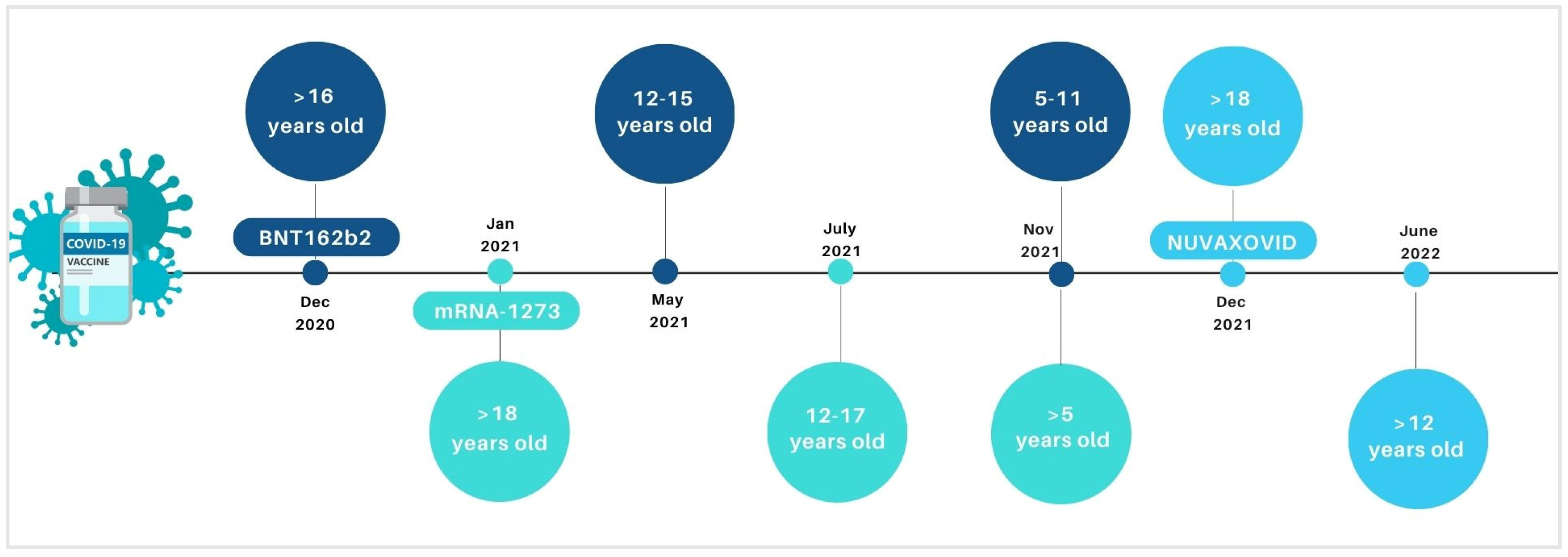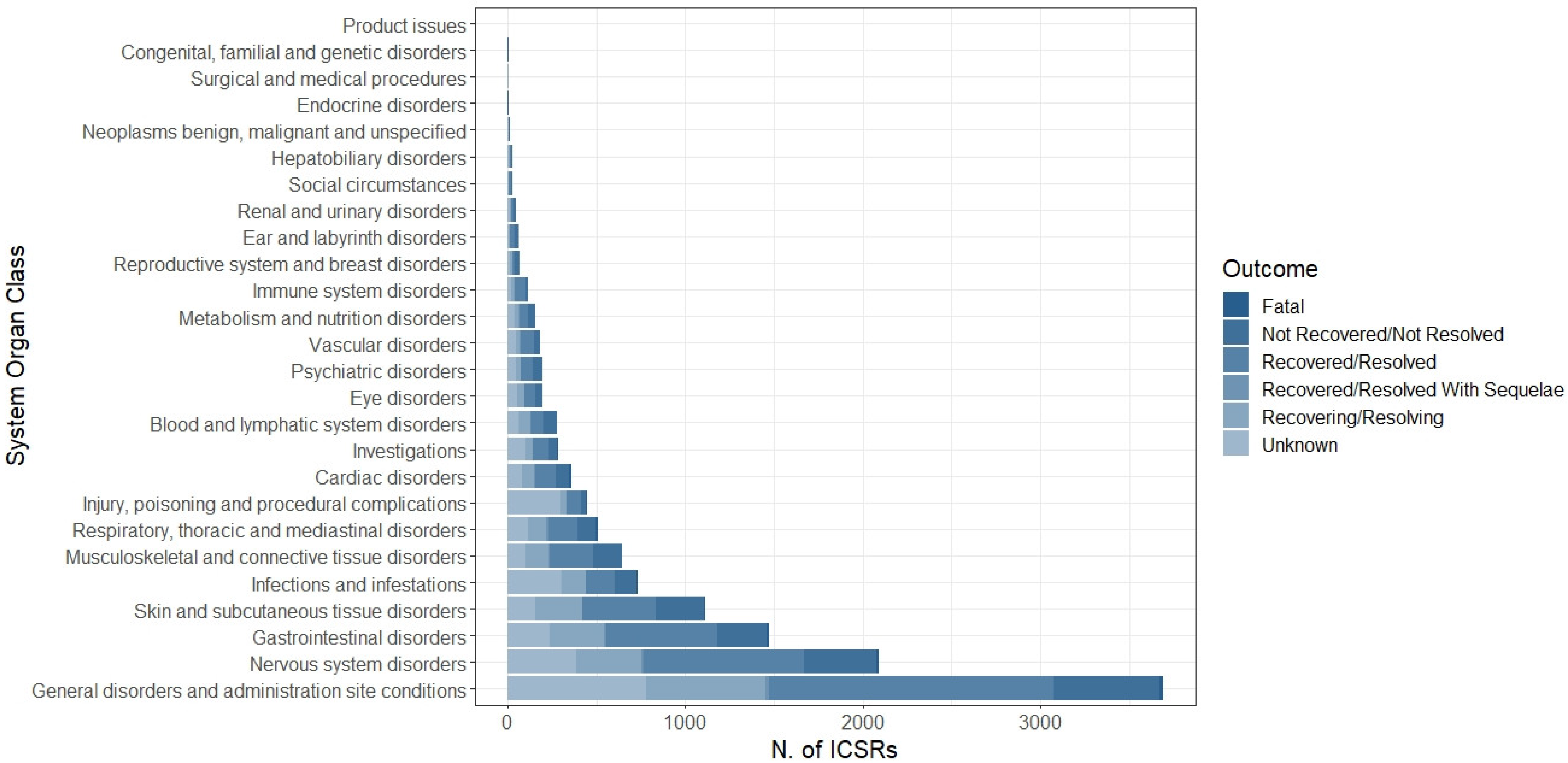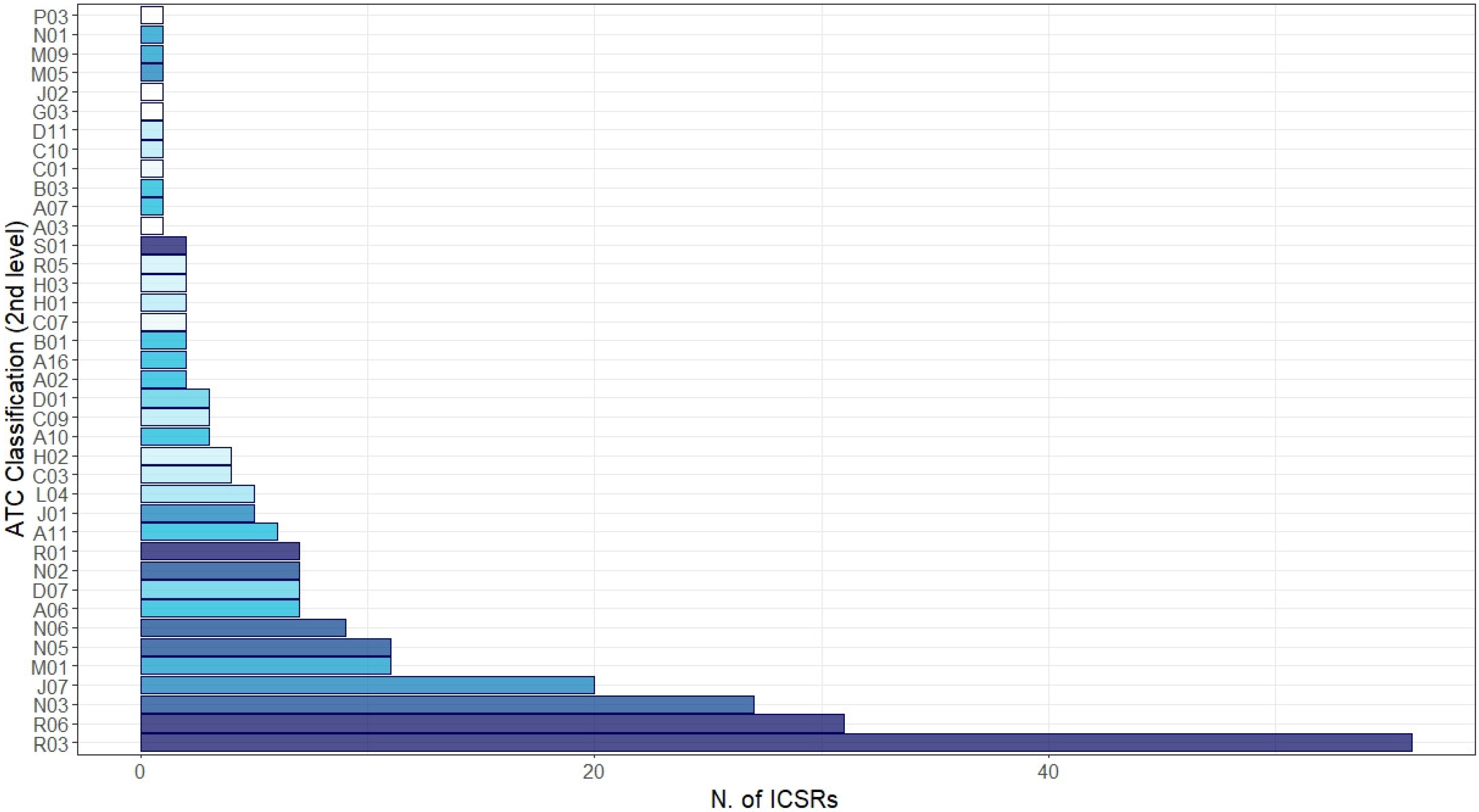Safety Monitoring of mRNA COVID-19 Vaccines in Children Aged 5 to 11 Years by Using EudraVigilance Pharmacovigilance Database: The CoVaxChild Study
Abstract
:1. Introduction
2. Materials and Methods
2.1. Data Source
2.2. Descriptive Analysis
2.3. Ethical Consideration
3. Results
3.1. Characteristics of Individual Case Safety Reports (ICSRs)
3.2. Multisystem Inflammatory Syndrome
4. Discussion
5. Strengths and Limitations
6. Conclusions
Author Contributions
Funding
Institutional Review Board Statement
Informed Consent Statement
Data Availability Statement
Conflicts of Interest
References
- European Medicines Agency. Comirnaty—European Public Assessment Report (EPAR). Available online: https://www.ema.europa.eu/en/medicines/human/EPAR/comirnaty (accessed on 1 October 2022).
- European Medicines Agency. Spikevax—European Public Assessment Reports (EPAR). Available online: https://www.ema.europa.eu/en/medicines/human/EPAR/spikevax (accessed on 1 October 2022).
- Staiano, A.; Agostiniani, R.; Bozzola, E.; Russo, R.; Corsello, G. COVID 19 vaccine in the paediatric age: The recommendation of the Italian Paediatric Society. Ital. J. Pediatr. 2022, 48, 46. [Google Scholar] [CrossRef] [PubMed]
- Alfieri, N.L.; Kusma, J.D.; Heard-Garris, N.; Davis, M.M.; Golbeck, E.; Barrera, L.; Macy, M.L. Parental COVID-19 vaccine hesitancy for children: Vulnerability in an urban hotspot. BMC Public Health 2021, 21, 1662. [Google Scholar] [CrossRef] [PubMed]
- Sinaei, R.; Pezeshki, S.; Parvaresh, S.; Sinaei, R. Why COVID-19 is less frequent and severe in children: A narrative review. World J. Pediatr. 2021, 17, 10–20. [Google Scholar] [CrossRef] [PubMed]
- Bhopal, S.S.; Bagaria, J.; Olabi, B.; Bhopal, R. Children and young people remain at low risk of COVID-19 mortality. Lancet Child Adolesc. Health 2021, 5, e12–e13. [Google Scholar] [CrossRef]
- European Centre for Disease Prevention and Control (ECDC). COVID-19 in Children and the Role of School Settings in TRANSMISSION—Second Update. Available online: https://www.ecdc.europa.eu/en/publications-data/children-and-school-settings-covid-19-transmission (accessed on 1 October 2022).
- Jone, P.-N.; John, A.; Oster, M.E.; Allen, K.; Tremoulet, A.H.; Saarel, E.V.; Lambert, L.M.; Miyamoto, S.D.; de Ferranti, S.D. SARS-CoV-2 Infection and Associated Cardiovascular Manifestations and Complications in Children and Young Adults: A Scientific Statement From the American Heart Association. Circulation 2022, 145, e1037–e1052. [Google Scholar] [CrossRef]
- European Centre for Disease Prevention and Control (ECDC). Latest Evidence: Clinical Characteristics of COVID-19. Available online: https://www.ecdc.europa.eu/en/covid19/latest-evidence/clinical (accessed on 1 October 2022).
- Noval Rivas, M.; Porritt, R.A.; Cheng, M.H.; Bahar, I.; Arditi, M. Multisystem Inflammatory Syndrome in Children and Long COVID: The SARS-CoV-2 Viral Superantigen Hypothesis. Front. Immunol. 2022, 13, 941009. [Google Scholar] [CrossRef]
- Rao, S.; Lee, G.M.; Razzaghi, H.; Lorman, V.; Mejias, A.; Pajor, N.M.; Thacker, D.; Webb, R.; Dickinson, K.; Bailey, L.C.; et al. Clinical Features and Burden of Postacute Sequelae of SARS-CoV-2 Infection in Children and Adolescents. JAMA Pediatr. 2022, 176, 1000–1009. [Google Scholar] [CrossRef]
- Bundle, N.; Dave, N.; Pharris, A.; Spiteri, G.; Deogan, C.; Suk, J.E. COVID-19 trends and severity among symptomatic children aged 0–17 years in 10 European Union countries, 3 August 2020 to 3 October 2021. Eurosurveillance 2021, 26, 2101098. [Google Scholar] [CrossRef]
- European Centre for Disease Prevention and Control (ECDC). Interim Public Health Considerations for COVID-19. Available online: https://www.ecdc.europa.eu/en/publications-data/interim-public-health-considerations-covid-19-vaccination-adolescents-eueea (accessed on 1 October 2022).
- European Medicines Agency. EudraVigilance—European Database of Suspected Adverse Reactions Related to Medicines: User Manual for Online Access via the Adrreports.eu Portal. Available online: https://www.ema.europa.eu/en/documents/regulatory-procedural-guideline/eudravigilance-european-database-suspected-adverse-reactions-related-medicines-user-manual-online_en.pdf (accessed on 1 October 2022).
- Rossi, C.; Ruggiero, R.; Sportiello, L.; Pentella, C.; Gaio, M.; Pinto, A.; Rafaniello, C. Did the COVID-19 Pandemic Affect Contrast Media-Induced Adverse Drug Reaction’s Reporting? A Pharmacovigilance Study in Southern Italy. J. Clin. Med. 2022, 11, 5104. [Google Scholar] [CrossRef]
- Yamoah, P.; Mensah, K.B.; Attakorah, J.; Padayachee, N.; Oosthuizen, F.; Bangalee, V. Adverse events following immunization associated with coronavirus disease 2019 (COVID-19) vaccines: A descriptive analysis from VigiAccess. Hum. Vaccin. Immunother. 2022, 18, 2109365. [Google Scholar] [CrossRef]
- Vigezzi, G.P.; Lume, A.; Minerva, M.; Nizzero, P.; Biancardi, A.; Gianfredi, V.; Odone, A.; Signorelli, C.; Moro, M. Safety Surveillance after BNT162b2 mRNA COVID-19 Vaccination: Results from a Cross-Sectional Survey among Staff of a Large Italian Teaching Hospital. Acta Biomed. 2021, 92, e2021450. [Google Scholar] [CrossRef] [PubMed]
- Green, M.S.; Peer, V.; Magid, A.; Hagani, N.; Anis, E.; Nitzan, D. Gender Differences in Adverse Events Following the Pfizer-BioNTech COVID-19 Vaccine. Vaccines 2022, 10, 233. [Google Scholar] [CrossRef] [PubMed]
- Leitzen, S.; Dubrall, D.; Toni, I.; Stingl, J.; Schulz, M.; Schmid, M.; Neubert, A.; Sachs, B. Analysis of the reporting of adverse drug reactions in children and adolescents in Germany in the time period from 2000 to 2019. PLoS ONE 2021, 16, e0247446. [Google Scholar] [CrossRef] [PubMed]
- Grabowski, J.; Wolff, M.; Pettersson, S.D.; Brancewicz, T.; Bidzan, L. Use of antihistamines for COVID-19 vaccine recipients with risk of anaphylaxis. Eur. J. Transl. Clin. Med. 2022, 5, 508. [Google Scholar] [CrossRef]
- Clothier, H.J.; Selvaraj, G.; Easton, M.L.; Lewis, G.; Crawford, N.W.; Buttery, J.P. Consumer reporting of adverse events following immunization. Hum. Vaccin. Immunother. 2014, 10, 3726–3730. [Google Scholar] [CrossRef]
- Avery, A.J.; Anderson, C.; Bond, C.M.; Fortnum, H.; Gifford, A.; Hannaford, P.C.; Hazell, L.; Krska, J.; Lee, A.J.; McLernon, D.J.; et al. Evaluation of patient reporting of adverse drug reactions to the UK “Yellow Card Scheme”: Literature review, descriptive and qualitative analyses, and questionnaire surveys. Health Technol. Assess. 2011, 15, 1–234. [Google Scholar] [CrossRef]
- Rolfes, L.; van Hunsel, F.; Wilkes, S.; van Grootheest, K.; van Puijenbroek, E. Adverse drug reaction reports of patients and healthcare professionals-differences in reported information. Pharmacoepidemiol. Drug Saf. 2015, 24, 152–158. [Google Scholar] [CrossRef]
- Walter, E.B.; Talaat, K.R.; Sabharwal, C.; Gurtman, A.; Lockhart, S.; Paulsen, G.C.; Barnett, E.D.; Muñoz, F.M.; Maldonado, Y.; Pahud, B.A.; et al. Evaluation of the BNT162b2 Covid-19 Vaccine in Children 5 to 11 Years of Age. N. Engl. J. Med. 2022, 386, 35–46. [Google Scholar] [CrossRef]
- Creech, C.B.; Anderson, E.; Berthaud, V.; Yildirim, I.; Atz, A.M.; Melendez Baez, I.; Finkelstein, D.; Pickrell, P.; Kirstein, J.; Yut, C.; et al. Evaluation of mRNA-1273 Covid-19 Vaccine in Children 6 to 11 Years of Age. N. Engl. J. Med. 2022, 386, 2011–2023. [Google Scholar] [CrossRef]
- Hause, A.M.; Shay, D.K.; Klein, N.P.; Abara, W.E.; Baggs, J.; Cortese, M.M.; Fireman, B.; Gee, J.; Glanz, J.M.; Goddard, K.; et al. Safety of COVID-19 Vaccination in United States Children Ages 5 to 11 Years. Paediatrics 2022, 150, e2022057313. [Google Scholar] [CrossRef]
- Bloise, S.; Marcellino, A.; Frasacco, B.; Gizzone, P.; Proietti Ciolli, C.; Martucci, V.; Sanseviero, M.; Del Giudice, E.; Ventriglia, F.; Lubrano, R. Cross-Sectional Survey on BNT162b2 mRNA COVID-19 Vaccine Serious Adverse Events in Children 5 to 11 Years of Age: A Monocentric Experience. Vaccines 2022, 10, 1224. [Google Scholar] [CrossRef]
- Salzman, M.B.; Huang, C.-W.; O’Brien, C.M.; Castillo, R.D. Multisystem Inflammatory Syndrome after SARS-CoV-2 Infection and COVID-19 Vaccination. Emerg. Infect. Dis. 2021, 27, 1944–1948. [Google Scholar] [CrossRef]
- Jain, E.; Donowitz, J.R.; Aarons, E.; Marshall, B.C.; Miller, M.P. Multisystem Inflammatory Syndrome in Children after SARS-CoV-2 Vaccination. Emerg. Infect. Dis. 2022, 28, 990–993. [Google Scholar] [CrossRef]
- Cole, L.D.; Slate, M.; Minneman, S.; Bozzella, M.J. Multisystem Inflammatory Syndrome after Breakthrough SARS-CoV-2 Infection in 2 Immunized Adolescents, United States. Emerg. Infect. Dis. 2022, 28, 1456–1459. [Google Scholar] [CrossRef] [PubMed]
- Karatzios, C.; Scuccimarri, R.; Chédeville, G.; Basfar, W.; Bullard, J.; Stein, D.R. Multisystem Inflammatory Syndrome Following SARS-CoV-2 Vaccination in Two Children. Paediatrics 2022, 150, e2021055956. [Google Scholar] [CrossRef]
- Yousaf, A.R.; Cortese, M.M.; Taylor, A.W.; Broder, K.R.; Oster, M.E.; Wong, J.M.; Guh, A.Y.; McCormick, D.W.; Kamidani, S.; Schlaudecker, E.P.; et al. Reported cases of multisystem inflammatory syndrome in children aged 12–20 years in the USA who received a COVID-19 vaccine, December, 2020, through August, 2021: A surveillance investigation. Lance. Child Adolesc. Health 2022, 6, 303–312. [Google Scholar] [CrossRef] [PubMed]
- European Medicines Agency. Meeting highlights from the Pharmacovigilance Risk Assessment Committee (PRAC) 25–28 October 2021. Available online: https://www.ema.europa.eu/en/news/meeting-highlights-pharmacovigilance-risk-assessment-committee-prac-25-28-october-2021 (accessed on 1 October 2022).
- Ouldali, N.; Bagheri, H.; Salvo, F.; Antona, D.; Pariente, A.; Leblanc, C.; Tebacher, M.; Micallef, J.; Levy, C.; Cohen, R.; et al. Hyper inflammatory syndrome following COVID-19 mRNA vaccine in children: A national post-authorization pharmacovigilance study. Lancet Reg. Health Eur. 2022, 17, 100393. [Google Scholar] [CrossRef]
- Hazell, L.; Shakir, S.A.W. Under-reporting of adverse drug reactions: A systematic review. Drug Saf. 2006, 29, 385–396. [Google Scholar] [CrossRef] [PubMed]
- Ferrajolo, C.; Capuano, A.; Trifirò, G.; Moretti, U.; Rossi, F.; Santuccio, C. Paediatric drug safety surveillance in Italian pharmacovigilance network: An overview of adverse drug reactions in the years 2001—2012. Expert Opin. Drug Saf. 2014, 13 (Suppl. S1), 9–20. [Google Scholar] [CrossRef] [PubMed]
- Rafaniello, C.; Ferrajolo, C.; Gaio, M.; Zinzi, A.; Scavone, C.; Sullo, M.G.; Rossi, F.; Berrino, L.; Capuano, A. Tisagenlecleucel in Children and Young Adults: Reverse Translational Research by Using Real-World Safety Data. Pharmaceuticals 2020, 13, 258. [Google Scholar] [CrossRef] [PubMed]
- Postigo, R.; Brosch, S.; Slattery, J.; van Haren, A.; Dogné, J.-M.; Kurz, X.; Candore, G.; Domergue, F.; Arlett, P. EudraVigilance Medicines Safety Database: Publicly Accessible Data for Research and Public Health Protection. Drug Saf. 2018, 41, 665–675. [Google Scholar] [CrossRef] [PubMed]




| BNT162b2 ICSRs a N = 4689 (96.9%) | mRNA-1273 ICSRs a N = 149 (3.1%) | All ICSRs a N = 4838 (100.0%) | |
|---|---|---|---|
| Sex | |||
| Male | 2330 (49.7) | 53 (35.6) | 2383 (49.3) |
| Female | 2263 (48.3) | 95 (63.8) | 2358 (48.7) |
| NA | 96 (2.0) | 1 (0.6) | 97 (2.0) |
| Primary Source Qualification | |||
| Non-Healthcare Professional | 2558 (54.5) | 42 (28.2) | 2600 (53.8) |
| Healthcare Professional | 2131 (45.5) | 107 (71.8) | 2238 (46.2) |
| Primary Source Country for Regulatory Purposes | |||
| European Economic Area | 3313 (70.7) | 51 (34.2) | 3364 (69.5) |
| Non-European Economic Area | 1376 (29.3) | 98 (65.8) | 1474 (30.5) |
| Report Type | |||
| Spontaneous | 4689 (100.0) | 149 (100.0) | 4838 (100.0) |
| Non-Spontaneous | - | - | - |
| Suspected drug(s) other than the COVID-19 vaccine | |||
| 0 | 4650 (99.2) | 143 (96.0) | 4793 (99.1) |
| 1 | 38 (0.7) | 6 (4.0) | 44 (0.8) |
| ≥2 | 1 (0.1) | - | 1 (0.1) |
| Concomitant drug(s) | |||
| 0 | 4637(99.0) | 149 (100.0) | 4786 (99.0) |
| 1 | 24 (0.5) | - | 24 (0.5) |
| 2 | - | - | - |
| ≥3 | 28 (0.5) | - | 28 (0.5) |
| BNT162b2 AEFIs a N = 12450 (97.6%) | mRNA-1273 AEFIs a N = 301 (2.4%) | All AEFIs a N = 12751 (100.0%) | |
|---|---|---|---|
| AEFI Seriousness | |||
| Serious | 4751 (38.2) | 183 (60.8) | 4934 (38.7) |
| Not Serious | 7699 (61.8) | 118 (39.2) | 7817 (61.3) |
| AEFI Seriousness Criteria | |||
| Other Medically Important Condition | 2743 (57.8) | 85 (46.4) | 2828 (57.3) |
| Caused/Prolonged Hospitalization | 1625 (34.2) | 94 (51.5) | 1719 (34.8) |
| Disabling | 163 (3.4) | 1 (0.5) | 164 (3.3) |
| Life Threatening | 134 (2.8) | 2 (1.1) | 136 (2.8) |
| Results in Death | 86 (1.8) | 1 (0.5) | 87 (1.8) |
| AEFI Outcome | |||
| Recovered/resolved | 4798 (38.5) | 75 (24.9) | 4873 (38.2) |
| Not recovered/not resolved | 2387 (19.2) | 41 (13.6) | 2428 (19.0) |
| Recovering/resolving | 2209 (17.7) | 153 (50.9) | 2362 (18.5) |
| Fatal | 86 (0.7) | 1 (0.3) | 87 (0.7) |
| Recovered with sequelae | 83 (0.7) | 3 (1.0) | 86 (0.7) |
| Unknown | 2887 (23.2) | 28 (9.3) | 2915 (22.9) |
| Median AEFIs per ICSR (IQR) | 2 (1–3) | 2 (1–3) | 2 (1–3) |
| System Organ Class and Lowest-Level Term | N. of Adverse Events (%) |
|---|---|
| General disorders and administration site conditions | 3690 (100.0) |
| Pyrexia | 899 (24.4) |
| Injection site pain | 436 (11.8) |
| Fatigue | 241 (6.5) |
| Drug ineffective | 212 (5.7) |
| Malaise | 169 (4.6) |
| Chest pain | 164 (4.4) |
| Vaccination site pain | 129 (3.5) |
| Nervous system disorders | 2089 (100.0) |
| Headache | 732 (35.0) |
| Syncope | 254 (12.2) |
| Dizziness | 216 (10.3) |
| Seizure | 142 (6.8) |
| Loss of consciousness | 81 (3.9) |
| Gastrointestinal disorders | 1471 (100.0) |
| Vomiting | 508 (34.5) |
| Nausea | 286 (19.4) |
| Abdominal pain | 227 (15.4) |
| Diarrhoea | 181 (12.3) |
| Abdominal pain upper | 74 (5.0) |
| Skin and subcutaneous tissue disorders | 1111 (100.0) |
| Rash | 307 (27.6) |
| Urticaria | 187 (16.8) |
| Pruritus | 112 (10.1) |
| Erythema | 72 (6.5) |
| Hyperhidrosis | 43 (3.9) |
| Rash pruritic | 33 (3.0) |
| Infections and infestations | 735 (100.0) |
| COVID-19 | 329 (44.8) |
| Influenza | 38 (5.2) |
| Suspected COVID-19 | 38 (5.2) |
| Herpes zoster | 37 (5.0) |
| Nasopharyngitis | 26 (3.5) |
| Appendicitis | 25 (3.4) |
| Musculoskeletal and connective tissue disorders | 643 (100.0) |
| Pain in extremity | 194 (30.2) |
| Myalgia | 135 (21.0) |
| Arthralgia | 98 (15.2) |
| Limb discomfort | 43 (6.7) |
| Muscular weakness | 23 (3.6) |
| Respiratory, thoracic, and mediastinal disorders | 508 (100.0) |
| Dyspnoea | 125 (24.6) |
| Cough | 104 (20.5) |
| Oropharyngeal pain | 61 (12.0) |
| Epistaxis | 39 (7.7) |
| Rhinorrhoea | 24 (4.7) |
| Injury, poisoning, and procedural complications | 447 (100.0) |
| Product administered to patient of inappropriate age | 80 (17.9) |
| Vaccination failure | 75 (16.8) |
| Off-label use | 51 (11.4) |
| Fall | 30 (6.7) |
| Product use issue | 19 (4.3) |
| Inappropriate schedule of product administration | 17 (3.8) |
| Overdose | 17 (3.8) |
| Contusion | 16 (3.6) |
| Vaccination error | 15 (3.4) |
Disclaimer/Publisher’s Note: The statements, opinions and data contained in all publications are solely those of the individual author(s) and contributor(s) and not of MDPI and/or the editor(s). MDPI and/or the editor(s) disclaim responsibility for any injury to people or property resulting from any ideas, methods, instructions or products referred to in the content. |
© 2023 by the authors. Licensee MDPI, Basel, Switzerland. This article is an open access article distributed under the terms and conditions of the Creative Commons Attribution (CC BY) license (https://creativecommons.org/licenses/by/4.0/).
Share and Cite
Zinzi, A.; Gaio, M.; Liguori, V.; Ruggiero, R.; Tesorone, M.; Rossi, F.; Rafaniello, C.; Capuano, A. Safety Monitoring of mRNA COVID-19 Vaccines in Children Aged 5 to 11 Years by Using EudraVigilance Pharmacovigilance Database: The CoVaxChild Study. Vaccines 2023, 11, 401. https://doi.org/10.3390/vaccines11020401
Zinzi A, Gaio M, Liguori V, Ruggiero R, Tesorone M, Rossi F, Rafaniello C, Capuano A. Safety Monitoring of mRNA COVID-19 Vaccines in Children Aged 5 to 11 Years by Using EudraVigilance Pharmacovigilance Database: The CoVaxChild Study. Vaccines. 2023; 11(2):401. https://doi.org/10.3390/vaccines11020401
Chicago/Turabian StyleZinzi, Alessia, Mario Gaio, Valerio Liguori, Rosanna Ruggiero, Marina Tesorone, Francesco Rossi, Concetta Rafaniello, and Annalisa Capuano. 2023. "Safety Monitoring of mRNA COVID-19 Vaccines in Children Aged 5 to 11 Years by Using EudraVigilance Pharmacovigilance Database: The CoVaxChild Study" Vaccines 11, no. 2: 401. https://doi.org/10.3390/vaccines11020401
APA StyleZinzi, A., Gaio, M., Liguori, V., Ruggiero, R., Tesorone, M., Rossi, F., Rafaniello, C., & Capuano, A. (2023). Safety Monitoring of mRNA COVID-19 Vaccines in Children Aged 5 to 11 Years by Using EudraVigilance Pharmacovigilance Database: The CoVaxChild Study. Vaccines, 11(2), 401. https://doi.org/10.3390/vaccines11020401






